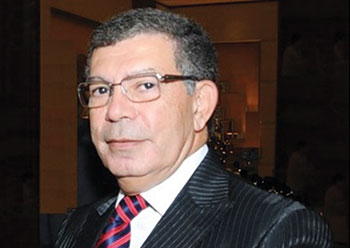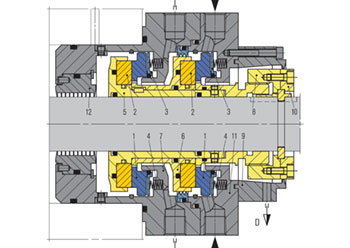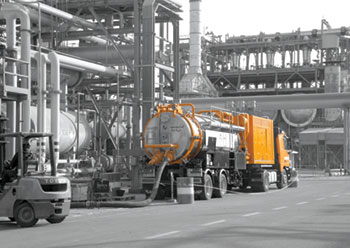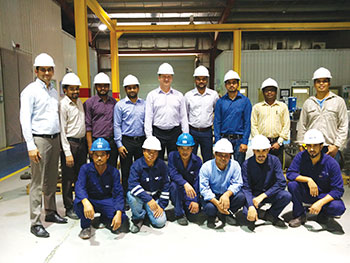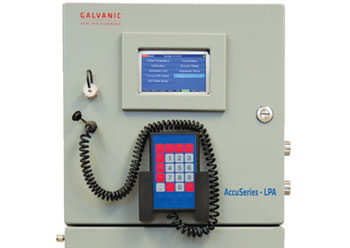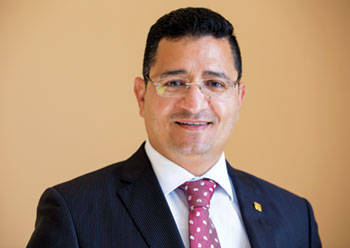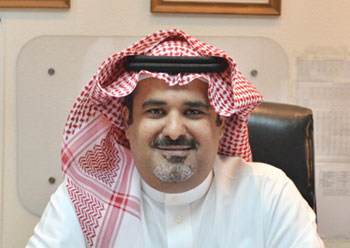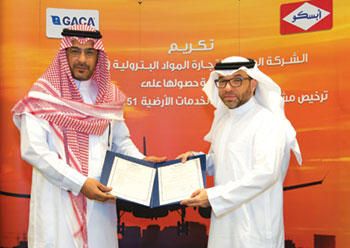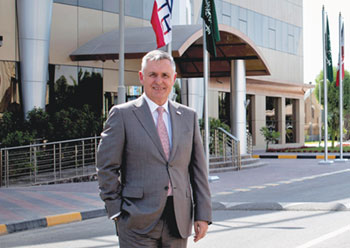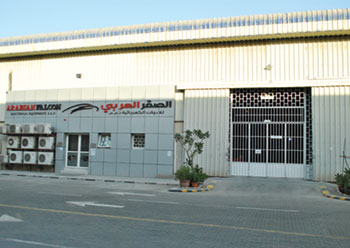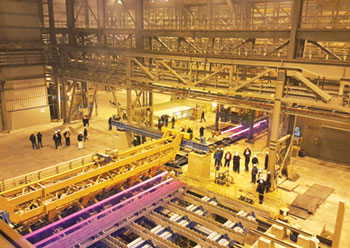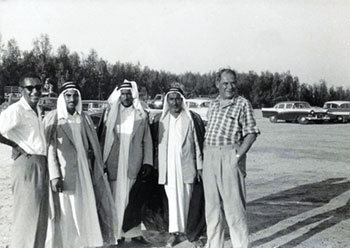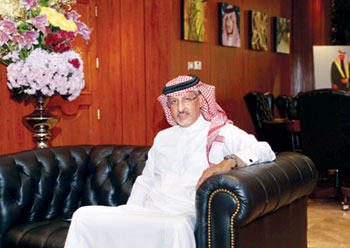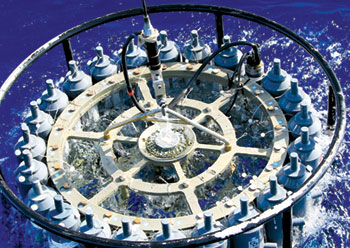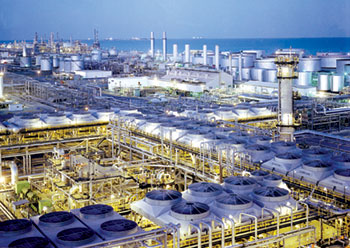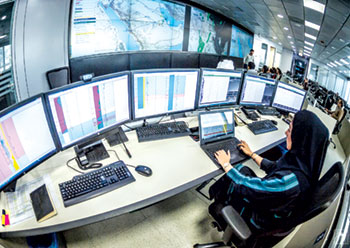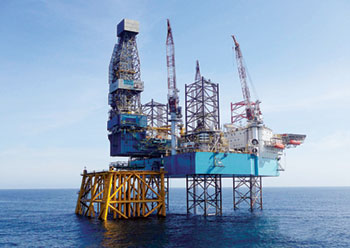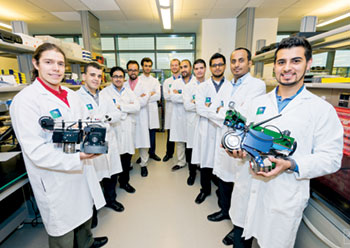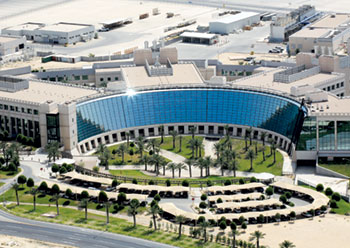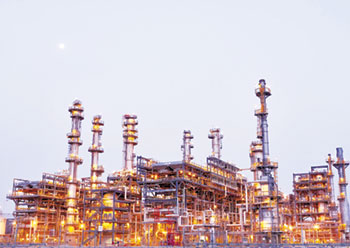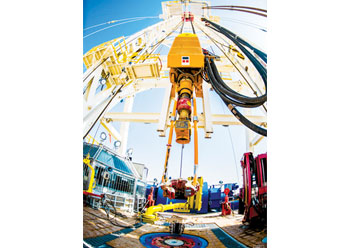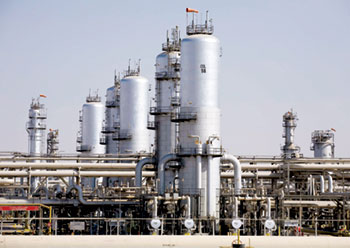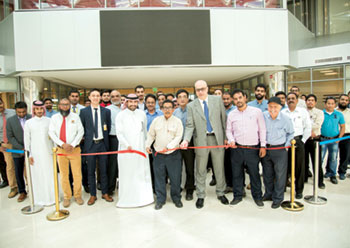
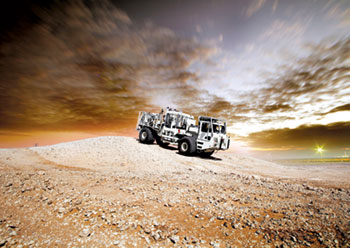 Reviewing exploration well site plans
Reviewing exploration well site plans
The Land Affairs Department is entrusted with ensuring access to land where the company can explore for, and develop, the kingdom’s rich oil and gas resources. Its duties include reviewing exploration well site plans against public records
As Adel A. Alqulaiti and Majed A. Al-Subaie park their company vehicle on the side of a skid road near the Khursaniyah Gas Plant, their eyes confirm what satellite and aerial photographs had warned them about.
Trained and experienced land representatives with Saudi Aramco’s Land Affairs Department (LAD), Alqulaiti and Al-Subaie use an iPad with Geographic Information System (GIS) software to verify that a pair of ring-fenced compounds full of workshops, storage sheds, and construction equipment have been built just a few metres away from a gas pipeline that is currently under construction.
Maps and aerial photos accessed on their iPad confirm this land is reserved by the government for Saudi Aramco. The presence of a non-Aramco compound so close to a pipeline is not only an illegal encroachment — it is potentially dangerous and a violation of Saudi law.
The next step, Alqulaiti and Al-Subaie conclude, will be to work with local government authorities to have this compound removed. It is all in a day’s work for employees of the LAD – the organisation entrusted with ensuring access to land where the company can explore for, and develop, the kingdom’s rich oil and gas resources.
With a wide range of duties such as reviewing exploration well site plans against public records, securing land through government reservations and private purchase, and detecting and removing encroachments, Land Affairs plays a critical role in maintaining the company’s position as the world’s leading supplier of energy.
The seven years of Umar S. Abdullatif’s tenure as LAD manager have been busy. LAD’s responsibilities have grown as the company’s own massive expansion of operations have expanded. From roughly 80,000 square kilometres (sq. km) in 2011, the company’s reservations have expanded to about 260,000 sq. km in 2017.
To manage the workload, LAD’s workforce has had to grow as well, from 41 in 2011 to 75 now — 11 of whom are female employees. "Land Affairs Department’s mission statement, which is at the centre of what we do, is to safeguard company land assets across the entire kingdom of Saudi Arabia," Abdullatif says.
"This allows the company’s business lines to operate effectively and without delay for the benefit of the kingdom’s economy." Being in charge of guaranteeing the company’s access to critical lands requires LAD to maintain a focus on customer needs, Abdullatif says.
"Through our dedicated team of professionals and consultants, LAD is always available to respond to Saudi Aramco proponents’ needs and requests in a timely manner." Customer focus LAD deals with a number of internal and external stakeholders.
Within the company, LAD works heavily with Exploration, Petroleum, and Pipelines to delineate areas of hydrocarbon potential proactively to reserve lands, and therefore, minimise conflicts. LAD also works with Law on land claims and Loss Prevention to ensure buffers are there to safeguard the public and the company’s facilities.
LAD also works with Government Affairs to resolve land encroachments and high-profile issues where land needs intercede. LAD works with the Project Management Office Department when responding to land-use permits (LUPs) and surveying lands. Outside the company, the department works with the Ministry of Energy, Industry and Mineral Resources, in addition to regional emirates, encroachment removal committees, the Ministry of Municipal and Rural Affairs, and the Bureau of Experts.
The demand for LAD services continue to increase. In 2010, LAD addressed 2,205 incoming letters for non-company land requests and reviewed 661 LUP review cases, and 123 well locations. In 2017, Land Affairs addressed 4,300 incoming letters for non-company land requests, and reviewed more than 3,400 LUP review cases and more than 600 well locations.
Azeb M. Al-Qahtani, manager of the Production and Facilities Development (P&FDD), says he considers LAD to be a key partner. "P&FDD and Land Affairs are working hand-in-hand on a continuous basis to address all land issues and support Saudi Aramco field developments, maintain potential and other projects to avail the required lands in a timely and cost-effective manner, and resolve land issues prior to the commencement of the project’s critical phases," Al-Qahtani says.
"From simple land inquiries to official high-level government committees, our colleagues in LAD represent the company needs and requirements to ensure protecting the company’s interest and our future oil and gas field development."
TECHNOLOGY
With 260,000 sq km of land (larger than the area of the U.K.) to protect and monitor, Land Affairs makes use of a wide range of technology, including: SAP Land Management System: This fully digitised system (integrated with the LUP and e-Zajil systems) allows land representatives to administer land records, examine all case documents, create maps and input spatial information for land requests, automatically identify land conflicts, and then prepare and send the company’s response.
GIS and remote sensing: GIS is designed to capture, store, manipulate, analyse, manage, and present spatial or geographic data. Remote sensing is the science and technology of obtaining data by a satellite or aircraft-based sensor technologies to detect and classify objects on Earth. LAD uses a combination of these technologies to make informed decisions about land requests.
Change Detection: This solution gathers satellite imagery and compares the images from two consecutive years — or quarters in some areas — to detect changes in land use, including potential land encroachments.
GIS Mobile Solution: Once a potential encroachment is identified, Land Affairs representatives utilise an iPad with customised software to better inspect potential encroachments by utilising GIS technology, updating maps in the field, collecting data, and updating the SAP Land Management database with the land request information.
THE PEOPLE
While technology is a key enabler, the secret to LAD’s success rests in its people. As the company’s operations grow, so does LAD’s workload, and to meet the company’s needs, LAD created a plan to ensure the development of a competent workforce.
This included the recruitment and development of staff members with legal backgrounds to address complex land claim issues in addition to continually developing business and legal writing skills. LAD also benefits from professionals with diverse education and experience in the areas of GIS, remote sensing, and business administration.
LAD representatives participate in a top fourlevel certification programme from the International Right-of-Way Association (IRWA). More than 40 of LAD’s land reps have completed IRWA certification.
ADVOCACY
As a key support organisation that interacts daily with the public and with the government, Land Affairs representatives serve as advocates on the company’s behalf. In conference rooms, seasoned Land Affairs representatives such as Mohsin A. Al-Tuwaijri engage with a variety of government agencies through dedicated committees established to review land issues.
In these committees, LAD representatives put forward the company’s interests and demonstrate their vital importance to the national economy. Not surprisingly, LAD representatives in the field find themselves acting as advocates on behalf of the company, especially whenever there is an opportunity to meet with the public.
During a recent field visit to the district of Namar, southwest of Riyadh, Abdullah M. Al-Amri and Abdulrahman S. Al-Shamrani met with a local businessman to discuss proper compensation for a piece of land owned by the businessman but reserved for Saudi Aramco by the government.
Working with a team from the Geomatics Services Division, Al-Amri and Al-Shamrani clarify just how much land the businessman owns, as surveyors set up a Trimble surveying system to mark out the land with incredible accuracy.
The Trimble uses real-time kinematic, a satellite navigation technique used to enhance the precision of position data that gives the surveyors the ability to survey land with a margin of error of just one millimetre. (By comparison, standard GPS devices or smartphone location services have a margin of error of up to 10 metres.)
Al-Amri and Al-Shamrani meet up with the landowner and walk to each of the four corners of his land, each of the corners marked by a length of rebar pounded into the ground. The surveyors do their work, and the landowner signs an agreement to meet with a local government committee for land issues and with LAD representatives to arrive at a fair compensation for his land.
GEOGRAPHICAL REACH
To ensure that Land Affairs reps are able to respond quickly and provide service throughout the kingdom, Land Affairs has been organised into four divisions according to professional function. These four divisions are as follows:
Land Rights Division and Reservation Affairs Division: The primary function of these two divisions is to secure lands for future operations. This can be achieved through a land reservation request filed with the government, or by an acquisition or an easement. The two divisions also review all private land requests (title deed and town plan requests) to ensure minimal conflict with the company’s land and operations.
Land Protection Division: This division’s main function is to ensure minimal interruption to critical company operations by proactively discouraging unauthorised land and working with Saudi Aramco proponents and government agencies to remove existing land encroachments in a timely manner.
Geospatial and System Support Division: In addition to managing and supporting LAD’s IT systems, the division utilises technology — GIS and satellite imagery — to review LUPs and well locations, as well as provide cartography services to other LAD divisions and advisory services to Saudi Aramco organisations for optimal land allocation and pipeline routing.
THE FUTURE
With an expanding portfolio of activities – in all business lines – the role of Land Affairs is the same that it has always been: To ensure the company’s success. The company’s challenges may become more complex, as it enters new regions of the kingdom and launch entirely new business activities.



































































